< Previous
PICTURESQUE AND WORTHY OF INSPECTION:
Sneinton echoes in the Church Cemetery, Nottingham: Part 2
By Stephen Best
[My apologies for omitting this introduction in SM71. Editor]
‘The cemetery is more than thirteen acres in extent, and is one of the most picturesque burial grounds in the United Kingdom, possessing some remarkable and spacious caverns and catacombs. Many of the graves and roads have been cut in the solid rock. The memorials of the dead and the floral tributes are worthy of inspection................... '
(J. Potter Briscoe: Murray’s Nottingham Guide, 1896).
Part One described several Church Cemetery gravestones with Sneinton links. Those commemorated included a daughter of George Green: the grandparents of DH Lawrence: and the last Sneinton miller before the restoration of Green’s Mill.
Here follows another gallery of characters variously associated with Sneinton.
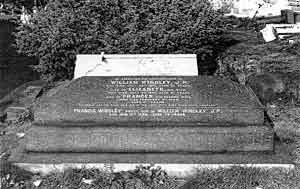 THE GRAVESTONE OF WILLIAM WINDLEY and his family, Francis, the son whose inscription is visible here, was, like his brother Thomas, a priest in the Church of England.(Stephen Best)
THE GRAVESTONE OF WILLIAM WINDLEY and his family, Francis, the son whose inscription is visible here, was, like his brother Thomas, a priest in the Church of England.(Stephen Best)ON THE EASTERN SIDE OF THE CHURCH Cemetery, in the dramatically landscaped sandstone defile near Mansfield Road known as the Rock Valley, are many memorials to men who shaped Victorian Nottingham's industrial and commercial prosperity. Among these are two who established important concerns in and around Sneinton.
The first is a massive coped stone in memory of William Windley, who died on 22 July 1877, aged 56. Windley was a silk throwster, who had lived in Park Valley before moving to Mapperley. A leading philanthropist in 19th-century Nottingham, he was one of a group of Anglican clergy and laymen who purchased land in locations in the town that would soon need new parish churches and schoolrooms. Windley bought a plot in the Sandfield, just off today's Waverley Street, and newly available for building. He financed the construction on it of All Saints’ church, parish rooms, vicarage, and verger's house, in Raleigh Street. This group, completed about 1864, was in memory of his father Thomas Windley, silk dyer of Finkhill Street, off Canal Street. Elsewhere in the Sandfield he built a parochial school. Windley's church, with the other buildings, cost some £10,000, and formed a focal point for this new middle-class housing development.
William Windley was also a leading promoter of St Jude's church, Mapperley. Indeed, he laid the foundation stone of the church in the year of his death, and his daughter was married to its curate. Windley had moved to that neighbourhood in 1857, to the new house designed for him by T.C. Hine, Nottingham’s most esteemed architect of the day, in what would become Alexandra Park. Named 'Fernleigh', it was later the home of John Dane Player, another great supporter of Nottingham good causes, who extensively altered and enlarged it. A magistrate, William Windley was officiating on the Bench when he suffered the first symptoms of what proved to be a fatal stroke.
Of him the Nottingham Journal wrote on the morning after his death: 'In speaking of Mr Windley it is almost unnecesssary to state that in politics he was a staunch Conservative, and in religious matters was a firm and unflinching supporter and member of the established Church... Quiet and unassuming in manner, simple in habits, always living out what he believed to be a simple Christian life, the town, as well as the Church, has lost in Mr Windley a man whose place will not readily be filled. His zeal in Church matters might have caused him to take a somewhat narrow view of men and things, but his integrity of character and thorough consistency it is impossible unduly to praise... He never sought municipal honours, and never was seen at public dinners, and what are called popular assemblies. He was the principal in the firm of Windley and Barwick, although of late he had not taken such an active part in business as was the case years ago...'
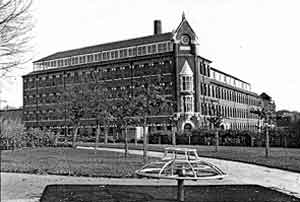 WINDLEY'S SILK FACTORY of 1869, in Robin Hood Street. Now usually known as Bancroft's Factory. (Stephen Best)
WINDLEY'S SILK FACTORY of 1869, in Robin Hood Street. Now usually known as Bancroft's Factory. (Stephen Best)It was as a partner in Windley and Barwick, formerly Walsh and Windley, that William Windley emphatically stamped his mark on the Sneinton landscape. He commissioned a new, and very impressive factory for his firm in Robin Hood Street; completed in 1869, this huge building remains a dominant accent in this comer of Sneinton. It is noteworthy on more than one account. A prominent range of large attic windows admits light to the inspection floor, but perhaps the most striking feature is the corner elevation. This incorporates a two- storey oriel window, with a gabled weather vane above, designed in such a way that many have mistaken it, on first sight, for a clock.
This undervalued area close to Sneinton Market is of considerable 19th-century architectural and landscape interest. Windley's former premises, now. Bancroft's Factory, exemplifies industry: the former Victoria Buildings and the houses in Promenade demonstrate two contrasting aspects of housing provision: the old Town Mission Ragged School represents education: while the Victoria Bath clock tower, and Victoria Park itself, bear witness to Nottingham's municipal activity in the fields of leisure and hygiene.
Windley's other principal link with Sneinton was a family one. His son, the Rev. Thomas Wilson Windley, served as vicar of Sneinton from 1884 until 1888, on the death of Canon Vernon Hutton. Following such a dynamic incumbent as Hutton cannot have been easy, and Windley's time at Sneinton has been characterized as 'subdued.' Perhaps he was fatigued by eight years spent as a missionary in Burma. T.W. Windley left Sneinton to become rector of a parish in Derbyshire. He returned to Nottingham in 1902, and for the next decade was vicar of the church built by his father.
(If repeated mention of All Saints' seems rather irrevelant to, and remote from, Sneinton, the reader may be surprised to find that it is possible to see the tower and spire of that church from Sneinton churchyard. It sounds improbable, but it can be done, from the extreme south-west corner, close to the junction of St Stephen's Road and Notintone Street. Hurry, though: something hideous may soon be built to block the view.)
Not far from the Windley gravestone our second Sneinton businessman lies buried. This one, however, also made his home in Sneinton for many years. His memorial, another huge horizontal stone with a coped top, is embellished by a large decorated cross. Its inscription reads:
HERE LIES THE BODY OF
FREDERICK PULLMAN
BORN 18TH FEBRUARY 1838, AT MORCHARD
BISHOP, DEVON
DIED 19TH SEPTEMBER 1906 AT SNEINTON.
Pullman came to Nottingham after school and apprenticeship in Exeter. Aged only 22, he founded his drapery business in Sneinton Street in 1859. Opening further premises in Derby Road, he became prominent in the commercial and public life of the town. In particular, Pullman's large and busy drapery emporium in Sneinton Street (now Lower Parliament Street) is still remembered by many older residents.
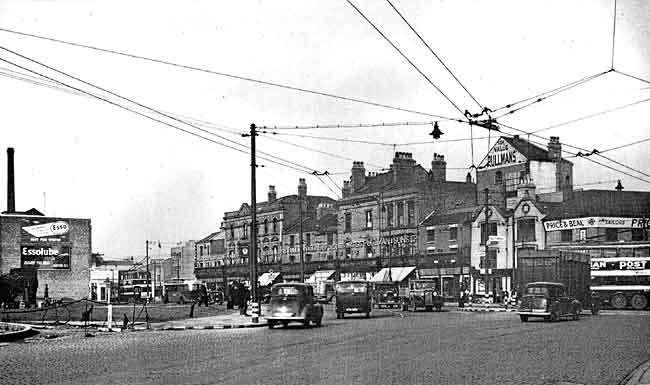 PULLMAN'S DRAPERY STORE just before the Second World War, stretching almost from Gedling Street to Southwell Road. The empty site on the left was filled by the Boots premises, which was recently demolished to make way for the new Ice Centre. (Courtesy of Nottingham Local Studies Library)
PULLMAN'S DRAPERY STORE just before the Second World War, stretching almost from Gedling Street to Southwell Road. The empty site on the left was filled by the Boots premises, which was recently demolished to make way for the new Ice Centre. (Courtesy of Nottingham Local Studies Library)In the course of time this shop occupied almost the entire block from Gedling Street to Southwell Road. By the end of the 1930s Pullman's ranged in higgledy-piggledy splendour through what had originally been seven or eight different buildings of various dates. These shop premises disappeared in the 1960s, after some 102 years of trading, and were replaced by the depressingly characterless row that still survives.
Frederick Pullman lived from the late 1870s until his death at 'Jasmine Cottage', 12 Castle Street, Sneinton. Gaining a seat as councillor for Manvers Ward in 1877, he served as sheriff in 1889/90. Four years later Alderman Pullman, as he had by then become, was elected Mayor of Nottingham. One of his duties as mayor must have given him particular satisfaction. During 1894 Pullman presided at the opening of the remodelled and greatly improved Victoria Park in Bath Street, only a minute or two away from his shop. He may well have reflected that this new amenity was within easy reach, too, of his Sneinton supporters. The name of this highly respected resident of the neighbourhood is commemorated by Pullman Road, off Sneinton Dale.
Industries of Nottingham, published in 1889, described Pullman's drapery as ’one of the best known, most popular, and reliable in the neighbourhood... The stock held includes every description of plain and fancy drapery, silks, linens, cashmeres, dresses, mantles, etc., etc., all of which Mr Pullman is enabled to supply, both wholesale and retail, at the lowest prices consistent with quality. Dress and mantle making is done on the premises by an experienced staff of hands. An efficient number of assistants is employed in the shop, and customers can always rely on receiving prompt and polite attendance.'
A further aspect of Frederick Pullman's interests was mentioned. He was an original promoter of the Nottingham Thursday Half- Holiday Association, and had been its president for twelve years. Not all employers were as concerned as Pullman about the welfare of their employees, and their need for a decent amount of leisure time. It is worthy of mention that not until 1892 was there an Act protecting young persons from having to work in shops for more than 74 hours a week. Not only that, it was 1911 before all shop assistants were by law entitled to meal intervals and one half-holiday each week.
Not long before his death, Frederick Pullman was featured in the local volume of a publication titled Men of the Period. This reported that he now owned three shops, and that 'those who know the reputation of this house and the character of the proprietor will not need to be informed as to the sound quality and perfect reliability of everything supplied.'
Pullman's obituary in the Nottingham Guardian, following his death from pernicious anaemia, paid generous tribute to a man who, as a committed Liberal, was not a political ally of that paper. Pullman, it reported, had been a director, not only of the company that bore his name, but of William Lawrence & Co., furniture makers, and Thomas Danks and Co., ironmongers. He had been a leading supporter of swimming and rowing clubs in Nottingham, and of the County Cricket Club. An opponent of Windley in politics, but sharing his allegiance to the Church of England, Frederick Pullman was a regular worshipper at St Mary's in the Lace Market.
We now make the acquaintance of someone who never approached Windley or Pullman in wealth. Few people, though, can have laboured longer, or more diligently, in the Sneinton area than our next figure. This humble and almost-forgotten man is buried in the north-eastern corner of the cemetery, just over the wall from the Forest Lodge. On yet another coped horizontal stone these words are carved:
SACRED TO THE MEMORY OF
THE REVEREND EDWARD RODGERS,
VICAR OF St LUKE'S
MARY JANE RODGERS
HIS DEVOTED WIFE AND HELPMATE
FOR FORTY YEARS WORKERS IN GOD'S
SERVICE IN THIS TOWN...
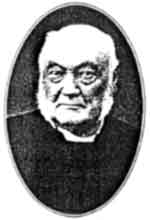 THE REV. EDWARD RODGERS IN OLD AGE.
THE REV. EDWARD RODGERS IN OLD AGE.Not many can now remember the time when St Luke's church stood in Carlton Road, opposite the foot of Walker Street. Closed in November 1924, and its parish united with St Philip's, Pennyfoot Street, the site of St Luke's was quickly occupied by the City Mission, and by a row of shops, now often empty. The old St Luke's parish schools for girls and infants, though they closed at the turn of the century, survive almost a hundred years later as the premises of the Tennant Rubber Company in Carlton Road.1
St Luke's church was consecrated in 1863, only two years before the Rev. Edward Rodgers arrived here in his middle forties, having been a curate at Christ Church, New Radford. His years at St Luke's were to be busy ones.
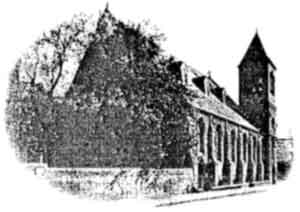 ST LUKE'S CHURCH, CARLTON ROAD.
ST LUKE'S CHURCH, CARLTON ROAD.A new parochial school for boys was opened at the corner of Liverpool Street and Salford Street; this was the gift of another member of the Windley family. Then, in 1879, came the culmination of years of devoted work at the Poplar Mission, in the Pennyfoot Street area, and part of St Luke's parochial responsibilities. A new parish church for that neighbourhood, St Philip's, was consecrated in 1879, and the St Luke's boundaries altered. Towards the close of the nineteenth century the parish experienced many changes. Many residents with sufficient means moved out of the older and more cramped parts of the parish to new suburbs, and there can be no doubt that Mr Rodgers and his wife found the going hard.
In what would prove to be the final year of his life, the vicar was saddened by the closure of the St Luke's Schools. New school buildings nearby, however, and the inadequacy of the old ones - they were crowded and had no playgrounds - made this inevitable. He died on 7 July 1900, aged eighty, his wife surviving him until the following year. Unlike some clergymen, who lived in gentler surroundings than those endured by their parishioners, Rodgers would have had a very good idea of what ordinary Sneinton life was like. His vicarage stood in Handel Street, and it is hard to think of anywhere much closer to the realities of Sneinton life.
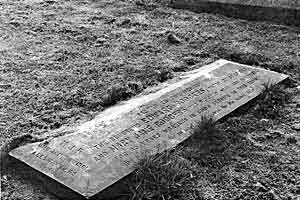 THE GRAVESTONE OF REV. EDWARD and MRS MARY JANE RODGERS. (Stephen Best)
THE GRAVESTONE OF REV. EDWARD and MRS MARY JANE RODGERS. (Stephen Best)In a brief obituary notice, the Nottingham Guardian recalled the late vicar's work and achievements: 'He was for three years chaplain of the Nottingham Borough Gaol, and had been vicar of St Luke’s for 35 years, during the earlier portion of which time the parish of St Philip’s, Pennyfoot Street, was formed, and the church built. The funds for the erection of this church were raised largely through Mr Rodgers's exertions, and as the district is poor and the population large, the new church was much needed. Mr Rodgers was not the oldest clergyman in Nottingham, but he had held a benefice in the city for a longer period than any other, and until his health began to fail, some years ago, he was actively associated with most phases of Church work.’
A photograph of Mr Rodgers shows a sturdy, shrewd-looking old gentleman, with bald head and long white side-whiskers. His expression suggests that he would take no nonsense from anybody, but one fancies that there is a trace of humour in his eyes and at the corners of his mouth.
Another personal note intrudes here: my Uncle George Best and his wife Mabel - my Godmother - were the fourth last couple to be married at St Luke's, on Sunday, 10 August 1924. They were wed on a Sunday because, my aunt told me, neither they nor the best man could not afford to take time off work.
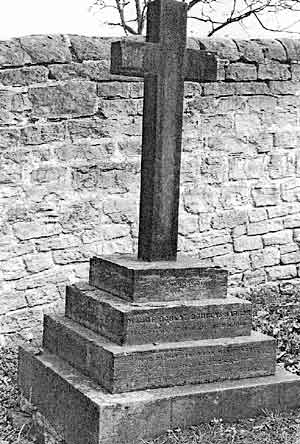 THE GRAVESTONE of MAJOR R D BARBOR, with the Forest boundary wall behind. (Stephen Best)
THE GRAVESTONE of MAJOR R D BARBOR, with the Forest boundary wall behind. (Stephen Best)Our final Church Cemetery memorial commemorates a man who did not, so far as we know, make any particular impression on Sneinton, but had the misfortune to die here. Right up against the Forest wall stands a tall cross on a stepped base, bearing this inscription:
IN MEMORY OF
MAJOR ROBERT DOUGLAS BARBOR
LATE CAPTAIN 6TH INNISKILLING DRAGOONS
WHO DIED AT SNEINTON MANOR HOUSE
AUGUST 10TH 1870
IN THE 60TH YEAR OF HIS AGE.
Sneinton Manor House was at that time the home of Colonel James Davidson, who, with his wife, had taken over the tenancy of the house following the death of Arthur Morley in 1860. A close link between
Barbor and Davidson arose from their having been fellow-officers in the Inniskilling Dragoons. Barbor had enlisted in 1828, for much of which year the Inniskillings' headquarters was in Nottingham; as Captain Barbor, he went on to half pay in June 1845, and in 1849 was appointed Paymaster to the Regiment. During the first ten years of his service the Dragoons served in Ireland for several years. Then, after returning to England they were present at Poor Law Riots in 1834, in particular at Sheffield and Ipswich.
James Davidson had joined the Inniskillings in 1838. Promoted from Cornet (the most junior commissioned rank) to Lieutenant in 1840, he became a Captain five years later, and retired with this rank in 1847. From 1838 until 1841 the Inniskillings were in Ireland again, during a period of unrest, and of agitation for the repeal of the Union. The regimental history characterizes this episode as: 'a wearisome tour of most unpleasant duty in aid of the civil power.'
The Inniskilling Dragoons were on duty on the occasion of Queen Victoria's only visit to Nottingham, in December 1843. Having been ordered to the town from Leeds, they received the Queen on her arrival at the Midland Station, and escorted her to Radcliffe-on-Trent and Bingham.
Three years after retiring from the Dragoons Davidson was gazetted Lieutenant in the South Notts Yeomanry Cavalry, and promoted Captain in 1866. He retired from the Yeomanry in 1871, and lived at Wilford for some years before moving to Sneinton Manor.
So Major Barbor's presence in Sneinton may be readily explained; it seems very likely that he was visiting his old friend and erstwhile fellow-Dragoon. The Nottingham newspapers carried a very brief announcement of Barbor's death; both (unlike the gravestone) gave his age as 60, the Review further stating that he had died suddenly.
I have referred to Davidson as Colonel, but some old residents of Sneinton would remember him as Major Davidson. We have seen, however, that Captain was the highest rank he achieved in the Inniskilling Dragoons and the South Notts Yeomanry Cavalry. In spite of this, he described himself in the 1861 census as 'Major, Militia, and farmer', and in 1871 as 'Col. of Militia and landowner.' James Davidson's will, following his death in February 1878, reveals the authority for these higher ranks. Davidson was, at the time of his death in his late fifties, a Lieutenant-Colonel in the Lanarkshire Militia. Perhaps the rank of Major ascribed to Richard Douglas Barbor also reflects service in the Militia?
In reporting his death, local newspapers were equally confused over just how far Davidson had progressed in the military, the Nottingham Daily Express calling him Major Davidson. The Nottingham Journal, however, accorded him his higher rank. This paper stated that the Colonel had been unwell for some time, but that his condition had not been thought dangerous. Feeling ill while out on Friday afternoon, he called in his doctor on getting home to the Manor. Ordered to bed, he died in the early hours of Saturday morning: 'from syncope, the action of the heart failing, owing, it is supposed, to indigestion.'
The report further remarked that Davidson 'was formerly connected, we believe, with a Scotch militia regiment, and had also served in the regular army. For some time also he held a commission in the South Notts Yeomanry. The deceased was a gentleman of unobtrusive character, but thoroughly efficient in his profession. His death will be lamented by a large circle of friends.' In the absence of any mention of Davidson's farming or landowning activities, it must be assumed that the profession in which he showed such efficiency was that of soldier.
Mrs Susan Davidson, who remained at Sneinton Manor for some ten years after her husband's death was, like him, a native of Ayrshire. She evidently continued the house custom of hospitality to military gentlemen, as present there on the night of the 1881 census was a visitor, in the person of another Colonel of the militia. Total propriety was observed, however; in addition to the widow and the Colonel, the Manor House had a substantial resident staff of domestic servants.
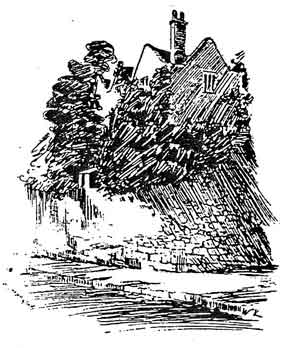 SNEINTON MANOR HOUSE shortly before its demolition: a drawing by William Kiddier.
SNEINTON MANOR HOUSE shortly before its demolition: a drawing by William Kiddier.About 1888 Earl Manvers, Lord of the Manor, announced his intention of selling the site for building development, and Mrs Davidson moved away a few years before demolition took place. Living until 1912, she was accorded an unofficial rise in status by locals, though it is likely that some gentle mockery was involved here. A liberal benefactor of local charitable causes, and a giver to the poor, she had, perhaps, something of the grand manner. Inevitably, she was known to Sneinton people as 'Lady Davidson.'
Barbor's burial in the Church Cemetery is of particular interest, as Sneinton churchyard was still open for interments in 1870, and the Manor House lay within easy hailing distance of it. The house stood between Sneinton Hollows and the presentday St Stephen's Road and Manor Street. The last two were built on the site of the Manor and its grounds after the house was pulled down in 1894.
By ordering the place of his death to be carved on his gravestone, however, his friends assured for Major Robert Douglas Barbor a permanent, though obscure, place in Sneinton's recorded history.
References to books and articles for further reading are given as they occur throughout the article.
I am grateful to Capt. W.A. Henshall, Assistant Regimental Secretary of the Royal Dragoon Guards, for helpful information about R.D. Barbor and James Davidson, and details of the locations of the Inniskilling Dragoons during their years of service.
Further articles on the Church Cemetery have appeared in Nottingham Civic Society Newsletter nos. 71-72, by Michael Peck, and nos. 89-92, by the Author.
A future article in Sneinton Magazine will describe some memorials in Nottingham General Cemetery which possess Sneinton associations.
Finally, I take this opportunity of thanking George Roberts, who has for so many years supplied me, and countless local historians, with copies of photographs of Nottingham, many of them from his own negatives.
1 A history of St Luke's church, A Low, Unpretending Building, can be found in Sneinton Magazine 19, 1985/86
< Previous
